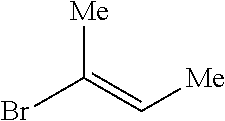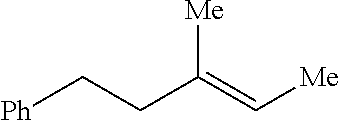Method of preparing trisubstituted ethylene compounds
a technology of ethylene compounds and substitutes, which is applied in the preparation of halogenated hydrocarbons, organic compounds/hydrides/coordination complexes, physical/chemical process catalysts, etc., can solve the problems of reducing the yield of desired products, complicated separation, and difficult or even impossible separation, so as to prolong reaction times, complicate separation, and high catalyst loading
- Summary
- Abstract
- Description
- Claims
- Application Information
AI Technical Summary
Benefits of technology
Problems solved by technology
Method used
Image
Examples
example 1
loro-3-methylbut-3-en-1-yl)benzene
[0178]Following the general procedure, a solution of Mo-carbene complex [(C6F5N)Mo(CMe2Ph)(Me2Py)(O-2,6(2,4,6-Et3Ph)2C6H3)] [Koh, M. J., Nguyen, T. T., Zhang, H., Schrock, R. R., Hoveyda, A. H. Nature 531, 459-465 (2016)] in benzene (0.1 M, 10 μL, 1.0 μmol) was transferred by syringe to an oven-dried vial containing E-1,2-dichloroethene (48.5 mg, 0.500 mmol) and (E)-(3-methylpent-3-en-1-yl)benzene (16.0 mg, 0.100 mmol). The resulting solution was allowed to stir for 4 h at 22° C. The reaction was quenched by addition of wet CDCl3 and analysis of the unpurified mixture revealed 98% consumption of (E)-(3-methylpent-3-en-1-yl)benzene. The resulting orange oil was purified by silica gel chromatography (100% pentane) to afford the product (14.6 mg, 0.0808 mmol, 81% yield) in 95:5 E:Z ratio as colorless oil. IR (neat): 3064 (w), 2926 (w), 2855 (w), 1641 (w), 1602 (w), 1454 (m), 1030 (m); 1H NMR (400 MHz, CDCl3): δ 7.32-7.26 (2H, m), 7.23-7.18 (1H, m), 7.1...
example 2
loro-3-methylbut-3-en-1-yl)benzene
[0179]Following the general procedure, a solution of the same catalyst as used in Example 1 in benzene (0.1 M, 15 μL, 1.5 μmol) was transferred by syringe to an oven-dried vial containing Z-1,2-dichloroethene (24.3 mg, 0.500 mmol) and (Z)-(3-methylpent-3-en-1-yl)benzene (8.0 mg, 0.0500 mmol). The resulting solution was allowed to stir for 4 h at 22° C. The reaction was quenched by addition of wet CDCl3 and analysis of the unpurified mixture revealed 98% consumption of (Z)-(3-methylpent-3-en-1-yl)benzene. The resulting orange oil was purified by silica gel chromatography (100% pentane) to afford the product (7.8 mg, 0.0432 mmol, 86% yield) in 91:9 Z:E ratio as colorless oil. IR (neat): 3027 (w), 2929 (w), 2859 (w), 1603 (w), 1494 (m), 1433 (m), 1031 (m), 741 (s), 700 (s); 1H NMR (400 MHz, CDCl3): E-isomer (major): δ 7.34-7.14 (5H, m), 5.80 (1H, dt, J=1.5, 0.7 Hz), 2.79-2.68 (2H, m), 2.55-2.46 (2H, m), 1.74 (3H, d, J=1.6 Hz); 13C NMR (100 MHz, CDCl3):...
example 3
rt-butyl)-4-(1-chloroprop-1-en-2-yl)benzene
[0180]Following the general procedure, a solution of Mo-carbene complex [(C6F5N)Mo(CMe2Ph)(Me2Py)(O-2,6(3,5-(t-Bu)2Ph)2C6H3)] [Nguyen, T. T., Koh, M. J., Shen, X., Romiti, F., Schrock, R. R., Hoveyda, A. H. Science 552, 569-575 (2016)] in benzene (0.1 M, 15 μL, 1.5 μmol) was transferred by syringe to an oven-dried vial containing Z-1,2-dichloroethene (24.2 mg, 0.250 mmol) and (E)-1-(but-2-en-2-yl)-4-(tertbutyl)benzene (9.4 mg, 0.0499 mmol). The resulting solution was allowed to stir for 4 h at 22° C. The reaction was quenched by addition of wet CDCl3 and analysis of the unpurified mixture revealed >98% consumption of (E)-1-(but-2-en-2-yl)-4-(tert-butyl)benzene. The resulting orange oil was purified by silica gel chromatography (100% pentane) to afford the product (9.4 mg, 0.0450 mmol, 90% yield) in >98:2 E:Z ratio as colorless oil. IR (neat): 3034 (w), 2962 (m), 2867 (w), 1620 (w), 1363 (m), 1245 (m), 1114 (m), 985 (m); 1H NMR (400 MHz, CDC...
PUM
| Property | Measurement | Unit |
|---|---|---|
| electrophilic | aaaaa | aaaaa |
| structure | aaaaa | aaaaa |
| chemical bonds | aaaaa | aaaaa |
Abstract
Description
Claims
Application Information
 Login to view more
Login to view more - R&D Engineer
- R&D Manager
- IP Professional
- Industry Leading Data Capabilities
- Powerful AI technology
- Patent DNA Extraction
Browse by: Latest US Patents, China's latest patents, Technical Efficacy Thesaurus, Application Domain, Technology Topic.
© 2024 PatSnap. All rights reserved.Legal|Privacy policy|Modern Slavery Act Transparency Statement|Sitemap



